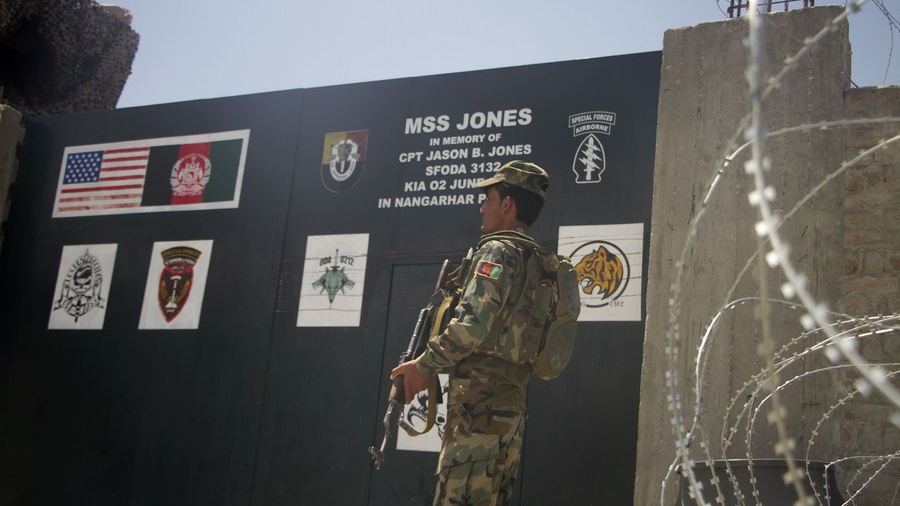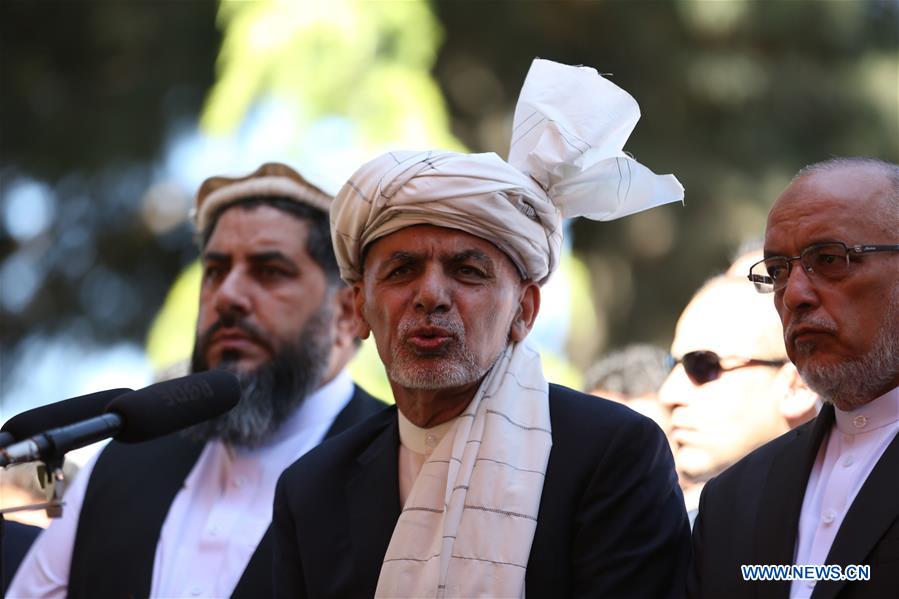
An Afghan border forces soldier stands guard at a U.S. forces base in Dih Bala district of Nangarhar province, eastern Afghanistan, July 20, 2020. /Xinhua
An Afghan border forces soldier stands guard at a U.S. forces base in Dih Bala district of Nangarhar province, eastern Afghanistan, July 20, 2020. /Xinhua
Editor's note: Hannan Hussain is a foreign affairs commentator and author. He is a Fulbright recipient at the University of Maryland, the U.S., and a former assistant researcher at Islamabad Policy Research Institute. The article reflects the author's opinions and not necessarily the views of CGTN.
New data released by the Special Inspector General for Afghanistan Reconstruction, a top U.S. watchdog, shows that enemy initiated attacks in Afghanistan over the past quarter topped the same period in 2019. This marked increase in violence directly contradicts NATO's belief that its conditions-based troop presence in Afghanistan will compel the Taliban to go nonviolent, induce action against militant safe havens and ensure that the Western coalition can contemplate full withdrawal from a position of strength.
Instead, the Taliban are warning that any of the 10,000 NATO troops retained beyond the May 2021 withdrawal deadline would constitute a "continuation of occupation in Afghanistan," while senior NATO sources contend sufficient troop levels shall remain.
By touting troop leverage and peace advances in equal measure, NATO risks reintroducing a new wave of Taliban offensives in Afghanistan beyond a stated withdrawal deadline, complicating Biden's task of bridging the Taliban trust deficit.
On diplomatic grounds, both NATO and the Afghan government have redoubled their interest in keeping coalition troops in Afghanistan.
"A combination of presence, plus diplomacy, bringing U.S. tools of power in a concentrated manner… would be extremely crucial to our success," said Afghan President Ashraf Ghani at the Aspen Security Forum, urging NATO to embrace a conditions-based approach to the Taliban.
But from Kabul's viewpoint, such troop retention ambitions cannot materialize "without U.S. enablers," given that the basis for NATO engagement in Kabul is to train and assist the Afghan Security Forces instead of military and strategic forecasting. NATO's over reliance on Washington to signal any shift in Afghanistan operations makes autonomous dictation of withdrawal plans a mirage to the Taliban.
Arguing in defense of May 2021 troop retention also defeats the purpose of a "political solution" to Washington's longest military engagement to date. Above all, the 2020 U.S.-Taliban peace deal – negotiated under the Trump administration and calling for a full withdrawal by May – stands to be flagrantly violated if the coalition's overdrive is not tempered.

Afghan President Ashraf Ghani speaks during the Eid al-Fitr prayer at the presidential palace in Kabul, capital of Afghanistan, June 4, 2019. /Xinhua
Afghan President Ashraf Ghani speaks during the Eid al-Fitr prayer at the presidential palace in Kabul, capital of Afghanistan, June 4, 2019. /Xinhua
Interestingly, without NATO pressing the Biden administration (and its forthcoming Kabul delegation) to engage the Taliban on collective withdrawal plans, the coalition fails to be seen as a "collective force" for anchoring peace in Afghanistan. In the process, it risks overstating its tactical leverage over skeptical Taliban insurgent factions.
For instance, NATO's revived image as a peace-building, troop-contributing giant is tied to synchronizing Afghan troop withdrawal with progress in Afghan-led Doha peace talks. That progress is likely to be judged by the Biden administration's clearly communicated metrics on revised U.S. coalition force structure and a new exit strategy that challenges Trump's hasty withdrawal risks, while minimizing Taliban's striking potential.
Under no compelling scenario, including this month's hotly anticipated NATO defense meeting, does the future of coalition troops depend on a stakeholder other than the United States. In fact, U.S. forces in Afghanistan insist that their "ability to execute… has thus far not been adversely affected by the 'reduction of force levels' [to 2,500 troops]." NATO appears to be arguing to the contrary. The coalition treats troop retention as some potent yet unexplained leverage over the Taliban. Pentagon's own assessments are unsupportive of such wishful thinking, suspecting possible resistance from the insurgents.
From the Taliban's perspective, the political status-quo in Kabul hangs by a light thread. Following the delegation's meeting in Tehran this week, the insurgents are reportedly banking on an Islamic government to replace the exceedingly unpopular Ashraf Ghani-ruling government – a noteworthy expression of defiance, considering that power-sharing talks are stalled, not defeated in Doha.
As a result, NATO's perceived continuity in Afghanistan's governance setup is an important consideration for its own survival. It did not establish Kabul as its marquee mission when key strategists deemed elements within the government as peace "spoilers."
As international perceptions towards Kabul's political infighting change condiand Ghani's leadership is tested during the Doha stalemate, NATO struggles to present its troop retention posture as binding on the Taliban, even under the garb of a "conditions-based" compliance.
Precisely for these nuanced militant motivations and power-sharing arrangements, Biden has refrained from ascertaining May troop levels, let alone threatening the Taliban with cosmetic leverage.
If the end goal of NATO's post-April troop ambitions was to honor Afghan peace and rein in the Taliban, it is pushing the insurgents to weigh confrontation instead: "We will have no choice [but] to continue our jihad and struggle."
(If you want to contribute and have specific expertise, please contact us at opinions@cgtn.com.)

